Wind-Thermal-Nuclear-Storage Combined Time Division Power Dispatch Based on Numerical Characteristics of Net Load
Abstract
:1. Introduction
2. Numerical Characteristic Analysis of the Net Load
3. Wind-Thermal-Nuclear-Storage Combined Time Division Power Dispatch Model
3.1. Thermal Generating Mode
3.2. Time Division Day-Ahead Power Dispatch Model
3.2.1. Objective Functions
3.2.2. Constraints
4. Case Study
4.1. Status Analysis of the Provincial Power Grid
4.2. The Actual Operating Environment and Parameters of the Provincial Power Grid
4.3. SampEn Calculation of the Net Load
4.4. Result Comparison and Analysis
- Case 1: Dispatch strategy without SampEn and the nuclear power is constant.
- Case 2: Dispatch strategy based on SampEn and the nuclear power is constant.
- Case 3: Dispatch strategy based on SampEn and the nuclear power is under “6-3-12-3” operation mode, where the nuclear generators are operating at high power level for 6 h, operating at low power level for 12 h, and ramping up and down for 3 and 3 h, respectively.
- Case 4: Dispatch strategy based on SampEn and the nuclear power is under “5-8-6-5” operation mode, where the nuclear generators are operating at high power level for 5 h, operating at low power level for 8 h, and ramping up and down for 6 and 5 h, respectively.
4.4.1. Results in Case 1
4.4.2. Results in Case 2
4.4.3. Results in Case 3
4.4.4. Results in Case 4
4.4.5. Result Comparison of Case 1 and Case 2
4.4.6. Result Comparison of Case 3 and Case 4
4.4.7. Result Comparison of Case 2 and Case 4
4.5. Discussion
4.5.1. Result Analysis of Case 1 and Case 2
4.5.2. Result Analysis of Case 3 and Case 4
4.5.3. Result Analysis of Case 2 and Case 4
5. Glossary/Nomenclature/Abbreviations
6. Conclusions
- In the provided wind-thermal-nuclear-storage combined time division power dispatch strategy, the net loads are the objects that need to be satisfied in the dispatch which are formed by the results of the renewable energy consumed by electric loads. In the strategy, the curtailment of renewable power is not allowed, which maximized the renewable energy utilization efficiency.
- A net load time division method is explained in detail, which can segment the dispatch time interval according to the numerical characteristics of the net loads. Further, the calculation process of the net loads SampEn is provided in detail, which can reflect the complexity of net loads. Further, the fitted thermal generation mode and nuclear generation mode are determined depending on the net load numerical characteristics.
- In the dispatch strategy with SampEn in Case 2, the throughput of the pumped storage 2 is 54.52% more than that without SampEn in Case 1, thus the dispatch strategy with SampEn improved the interaction between pumped storage and renewable energies. Moreover, the thermal generator ramping time periods are reduced and the up and down ramping power in Case 2 based on SampEn are 34.70% and 42.90% lower than that without SampEn in Case 1. Therefore, the duration of thermal generator stable operation is increased and the stability of the system is improved.
- The nuclear generating mode of constant generation mode, time division generation mode, and net load tracking generation mode are compared and analyzed. The constant generation with a high power level of nuclear in Case 2 is with a highest economy and the peak shaving of nuclear generation is prevented. The net load tracking generation mode in Case 4 achieved the lowest up and down ramping power of thermal generators. Thus, we can draw a conclusion that the economy pursuit generation mode of nuclear can be the constant generation mode at a high power level and the thermal generation stability friendly generation mode of nuclear can be the net load tracking generation mode.
Author Contributions
Funding
Conflicts of Interest
Appendix A
References
- Lu, Z.X.; Huang, H.; Shan, B.G.; Wang, Y.H.; Du, S.H.; Li, J.H. Morphological evolution model and power forecasting prospect of future electric power systems with high proportion of renewable energy. Autom. Electr. Power Syst. 2017, 41, 12–18. [Google Scholar]
- Energy Research Institute of the National Development and Reform Commission. 2050 High Proportion Renewable Energy Development Scenario and Path Study in China; Institute of Energy, National Development and Reform Commission: Beijing, China, 2015. [Google Scholar]
- Kang, C.Q.; Yao, L.Z. Key scientific issues and theoretical research framework for power systems with high proportion of renewable energy. Autom. Electr. Power Syst. 2017, 41, 2–11. [Google Scholar]
- Xu, F.; Li, L.L.; Chen, Z.X.; Tu, M.F.; Ding, Q. Generation scheduling model and application with fluctuation reduction of unit output. Autom. Electr. Power Syst. 2012, 36, 45–50. [Google Scholar]
- Wang, W.; Sun, Y.; Liu, J.Z. load-change control strategy for combined heat and power units adapted to rapid frequency regulation of power grid. Autom. Electr. Power Syst. 2018, 42, 63–69. [Google Scholar]
- Yang, Y.S.; Zhang, J.; Feng, T.T. Study on compensation mechanism for Ppak-regulating ancillary service of nuclear units. Power Syst. Technol. 2017, 41, 908–913. [Google Scholar]
- Correa-Posada, C.M.; Sanchez-Martin, P. Integrated power and natural gas model for energy adequacy in short-term operation. IEEE Trans. Power Syst. 2016, 30, 3347–3355. [Google Scholar]
- Liu, Q.; Wu, G.Y.; Song, X.L.; Su, Z.D.; Huang, J.D.; Su, Y. Modeling of large-capacity nuclear power unit suitable for power grid stability analysis. Power Syst. Technol. 2017, 41, 908–913. [Google Scholar]
- Jia, H.J.; Wang, D.; Xu, X.D.; Yu, X.D. research on some key problems related to integrated energy systems. Autom. Electr. Power Syst. 2015, 39, 198–207. [Google Scholar]
- Wang, J.; Zhao, J.; Liu, D.; Shao, Y.; Wang, H. Optimal scheduling model of peak load regulation considering participation of nuclear power plant. Proc. CSEE 2018, 38, 1665–1674. [Google Scholar]
- Zhou, B.R.; Geng, G.C.; Jiang, Q.Y. Hydro-thermal-wind coordination in day-ahead unit commitment. IEEE Trans. Power Syst. 2016, 31, 4626–4637. [Google Scholar]
- Jiang, R.; Wang, J.; Guan, Y. Robust unit commitment with wind power and pumped storage hydro. IEEE Trans. Power Syst. 2012, 27, 800–810. [Google Scholar] [CrossRef]
- Sun, H.; Shen, Z.H.; Zhou, W.; Sun, Q.Z.; Sun, M.Z.; Wang, Z.H. multi-objective congestion dispatch of active distribution network based on source-load coordination. Autom. Electr. Power Syst. 2017, 41, 88–95. [Google Scholar]
- Hu, S.B.; Sun, H.; Peng, F.X.; Zhou, W.; Cao, W.P.; Su, A.L.; Chen, X.D.; Sun, M.Z. Optimization strategy for economic power dispatch utilizing retired EV batteries as flexible loads. Energies 2018, 11, 1657. [Google Scholar] [CrossRef] [Green Version]
- Chazarra, M.; Perez-Diaz, J.I.; Garcia-Gonzalez, J. Optimal joint energy and secondary regulation reserve hourly scheduling of variable speed pumped storage hydropower plants. IEEE Trans. Power Syst. 2018, 33, 103–115. [Google Scholar] [CrossRef]
- Bruninx, K.; Dvorkin, Y.; Delarue, E.; Hrvoje, P.; Kirschen, D.S. Coupling pumped hydro energy storage with unit commitment. IEEE Trans. Sustain. Energy 2016, 7, 786–796. [Google Scholar] [CrossRef]
- Lannoye, E.; Flynn, D.; O’Malley, M. Assessment of power system flexibility: A high-level approach. In Proceedings of the IEEE Power & Energy Society General Meeting, San Diego, CA, USA, 22–26 July 2012; pp. 1–8. [Google Scholar]
- Li, J.; Wang, S.; Ye, L.; Fang, J. A coordinated dispatch method with pumped-storage and battery-storage for compensating the variation of wind power. Prot. Control Mod. Power Syst. 2018, 3, 2. [Google Scholar] [CrossRef] [Green Version]
- Papavasiliou, A.; Oren, S.S.; O’Neill, R.P. Reserve requirements for wind power integration: A scenario-based stochastic programming framework. IEEE Trans. Power Syst. 2011, 26, 2197–2206. [Google Scholar] [CrossRef] [Green Version]
- Matos, M.A.; Bessa, R.J. Setting the operating reserve using probabilistic wind power forecasts. IEEE Trans. Power Syst. 2011, 26, 594–603. [Google Scholar] [CrossRef]
- Wu, Y.K.; Chang, L.T.; Su, P.E.; Hsieh, T.Y.; Jan, B.S. Assessment of potential variability of net load following the integration of 3 GW wind power in Taiwan. Energy Procedia 2016, 100, 117–121. [Google Scholar] [CrossRef] [Green Version]
- Zhang, L.; Yang, J.; Jian, X.H.; Zhang, F.; Han, X.S. Unit Commitment with Energy Storage Considering Operation Flexibility at Sub-hourly Time-scales. Autom. Electr. Power Syst. 2018, 42, 48. [Google Scholar]
- Zou, G.; Ma, Y.; Yang, J.; Hou, M. Multi-time scale optimal dispatch in adn based on milp. Int. J. Electr. Power Energy Syst. 2018, 102, 393–400. [Google Scholar] [CrossRef]
- Gao, M.; Wu, R.B.; Zhang, X.Q.; Yin, Y.; Hu, Y.; Ge, X.Y. Study and application of economic dispatch with power plant generation change constraints. Mach. Electron. 2017, 35, 15–18. [Google Scholar]
- Yong, T.; Yao, J.; Yang, S.; Yang, Z. Ramp enhanced unit commitment for energy scheduling with high penetration of renewable generation. In Proceedings of the 2015 IEEE Power & Energy Society General Meeting, Denver, CO, USA, 26–30 July 2015. [Google Scholar]
- Juan, M.; Mahdi, P.; Matti, L.; José, R. Optimal location-allocation of storage devices and renewable-based dg in distribution systems. Electr. Power Syst. Res. 2019, 172, 11–21. [Google Scholar]
- Hong, L.; Jie, D.; Zhang, D.Y.; Yang, J.H. A distributed energy resources aggregation model based on multi-scenario and multi-objective methodology. Appl. Sci. 2019, 9, 3586. [Google Scholar]
- Gao, S.; Zhang, Y.Q.; Liu, Y. Incorporating concentrating solar power into high renewables penetrated power system: A chance-constrained stochastic unit commitment analysis. Appl. Sci. 2019, 9, 2340. [Google Scholar] [CrossRef] [Green Version]
- Shaker, H.; Zareipour, H.; Wood, D. Impacts of large-scale wind and solar power integration on California’s net electrical load. Renew. Sustain. Energy Rev. 2016, 58, 761–774. [Google Scholar] [CrossRef]
- Xia, J.N. Multiscale Irreversibility and Complexity Analysis of Time Series; Beijing Jiaotong University: Beijing, China, 2017. [Google Scholar]
- Han, S.W.; Myung-Whun, K. An information entropy interpretation of photon absorption by dielectric media. Opt. Commun. 2020, 454, 124447. [Google Scholar] [CrossRef]
- Skoric, T.; Mohamoud, O.; Milovanovic, B.; Japundzic-Zigon, N.; Bajic, D. Binarized cross-approximate entropy in crowd sensing environment. Comput. Biol. Med. 2017, 80, 137–147. [Google Scholar] [CrossRef]
- Richman, J.S.; Moorman, J.R. Physiological time-series analysis using approximate entropy and sample entropy. Am. J. Physiol. Heart Circ. Physiol. 2000, 278, 2039–2049. [Google Scholar] [CrossRef] [Green Version]
- Xu, W. The Complexity Algorithms Research of Chaotic Sequences Based on Entropy Theory. Ph.D. Thesis, Heilongjiang University, Harbin, China, 2017. [Google Scholar]
- Sun, W.; Wang, Y. Short-term wind speed forecasting based on fast ensemble empirical mode decomposition, phase space reconstruction, sample entropy and improved back-propagation neural network. Energy Convers. Manag. 2018, 157, 1–12. [Google Scholar] [CrossRef]
- Costa, M.; Goldberger, A.L.; Peng, C.K. Multiscale entropy analysis of complex physiologic time series. Phys. Rev. Lett. 2007, 89, 705–708. [Google Scholar] [CrossRef] [PubMed] [Green Version]
- International Atomic Energy Agency. Operating Experience with Nuclear Power Stations in Member States in 2014; International Atomic Energy Agency: Vienna, Austria, 2015. [Google Scholar]
- Chen, X.X.; Zhang, L.Z.; Yang, M.; Zhu, Y. A method for agc reserve capacity analysis considering photovoltaic power fluctuation characteristics. Autom. Electr. Power Syst. 2015, 39, 16–21. [Google Scholar]
- Bludszuweit, H.; Dominguez-Navarro, J.A.; Llombart, A. Statistical analysis of wind power forecast error. IEEE Trans. Power Syst. 2008, 23, 991. [Google Scholar] [CrossRef]
- A Special Study on China’s Sustainable Energy Development Strategy; Science Press: Beijing, China, 2006.
- Yan, K. Water Conservancy Dictionary; Shanghai Lexicographical Publishing House: Shanghai, China, 1994; p. 447. [Google Scholar]
- Liu, F.; Pan, Y.; Yang, J.F.; Zhou, J.Y.; Zhou, J.Y.; Zhu, Z.L.; Li, Q. Unit commitment model for combined optimization of wind power-thermal power-pumped storage hydro. Proc. CSEE 2015, 35, 766–775. [Google Scholar]
- Xu, F.; Liu, J.; Zang, T.; Ding, Q.; Tu, M.F. Unit commitment problem with pumped-storage units. Autom. Electr. Power Syst. 2012, 36, 36–40. [Google Scholar]
- Zhao, J.; Liu, D.C.; Lei, Q.S.; Du, Z.; Wang, J.; Zhou, L.; Huang, Y. Analysis of nuclear power plant participating in peak load regulation of power grid and combined operation with pumped storage power plant. Proc. CSEE 2011, 31, 1–6. [Google Scholar]
- Sui, X.; Lu, S.Y.; Su, A.L.; Sun, H.; Zhou, W.; Li, H. Source load interactive optimization scheduling method for nuclear peak regulation based on power to gas technology. Proc. CSU-EPSA 2019, 1–9. [Google Scholar] [CrossRef]
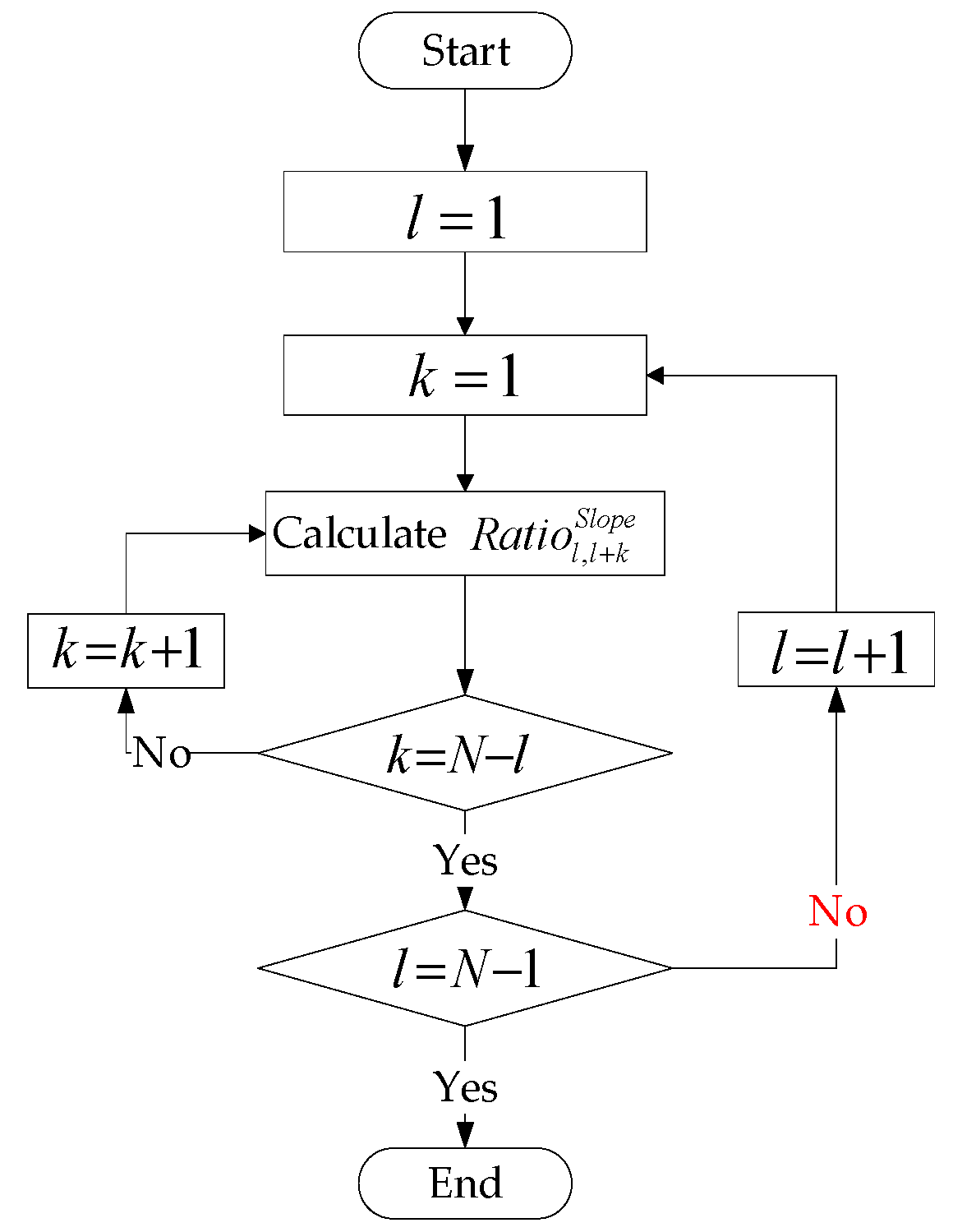
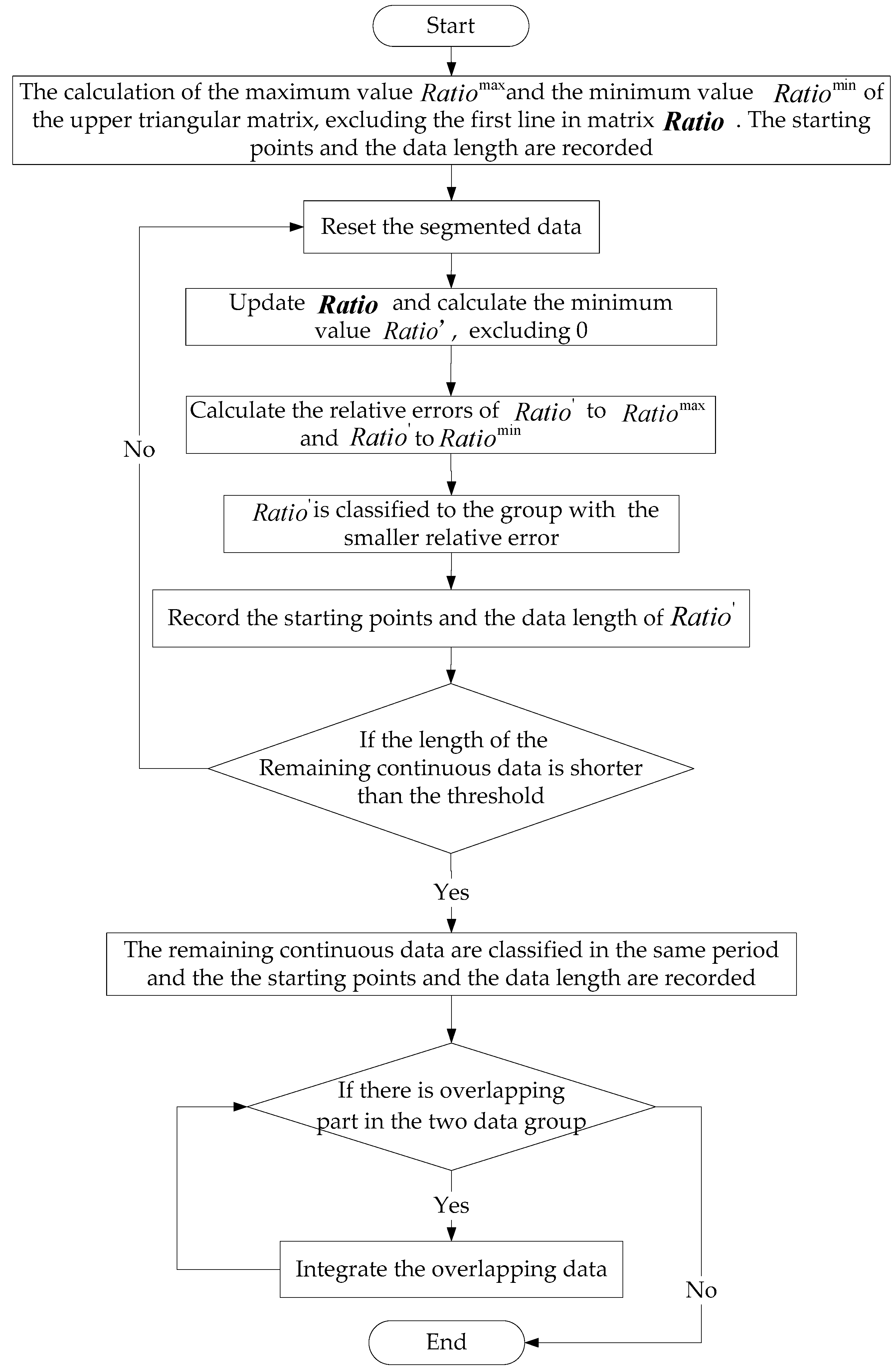
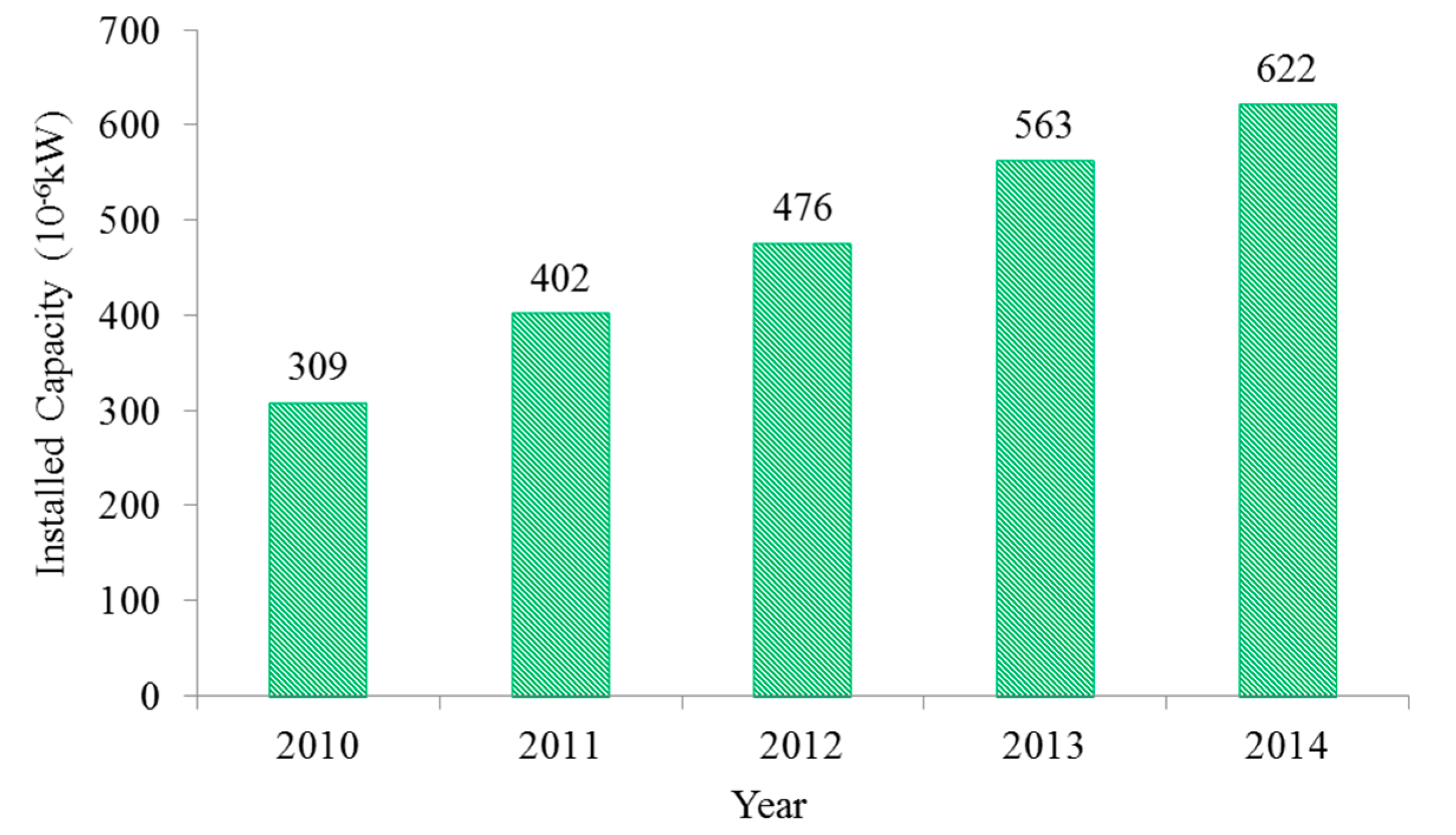
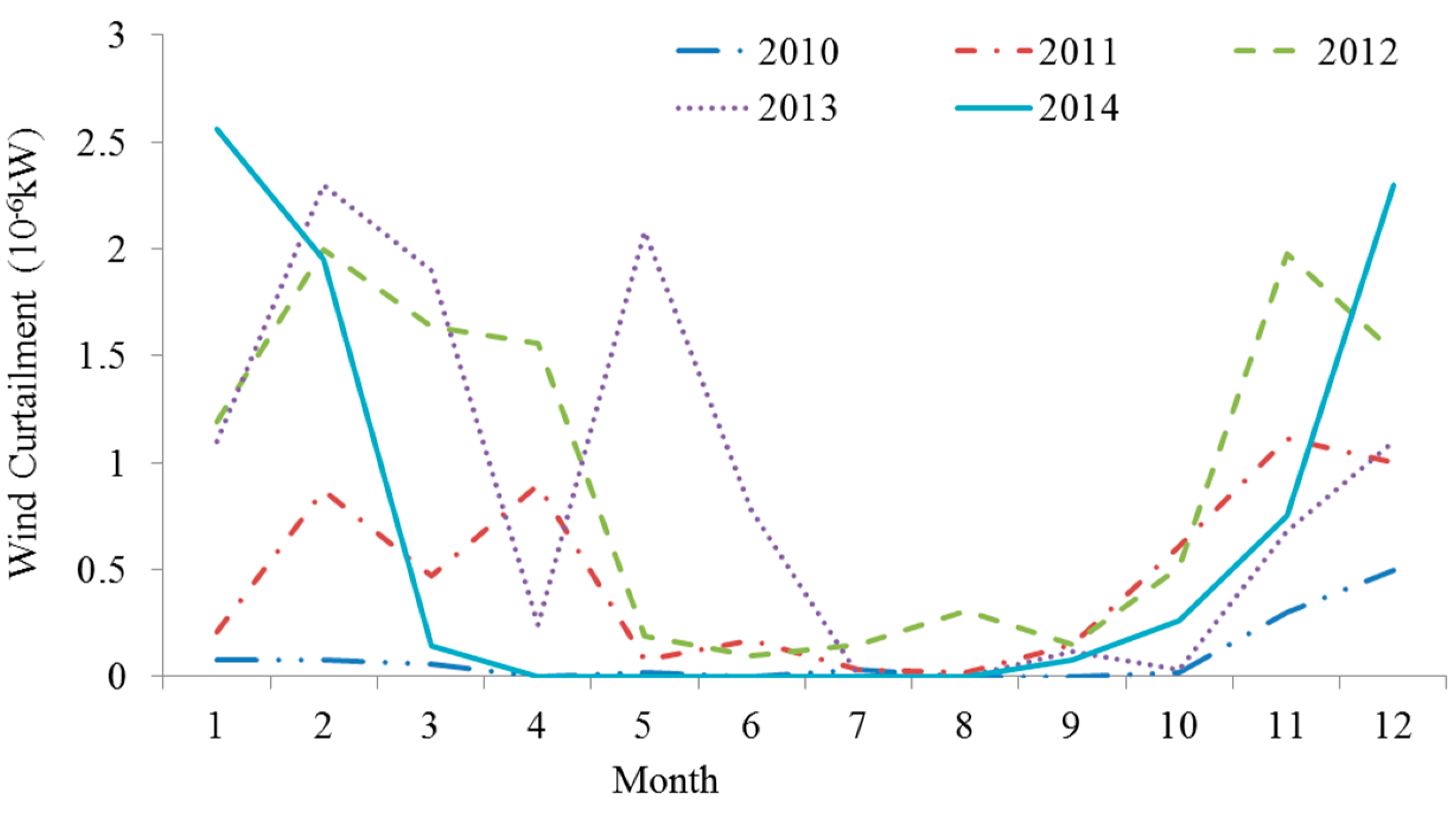
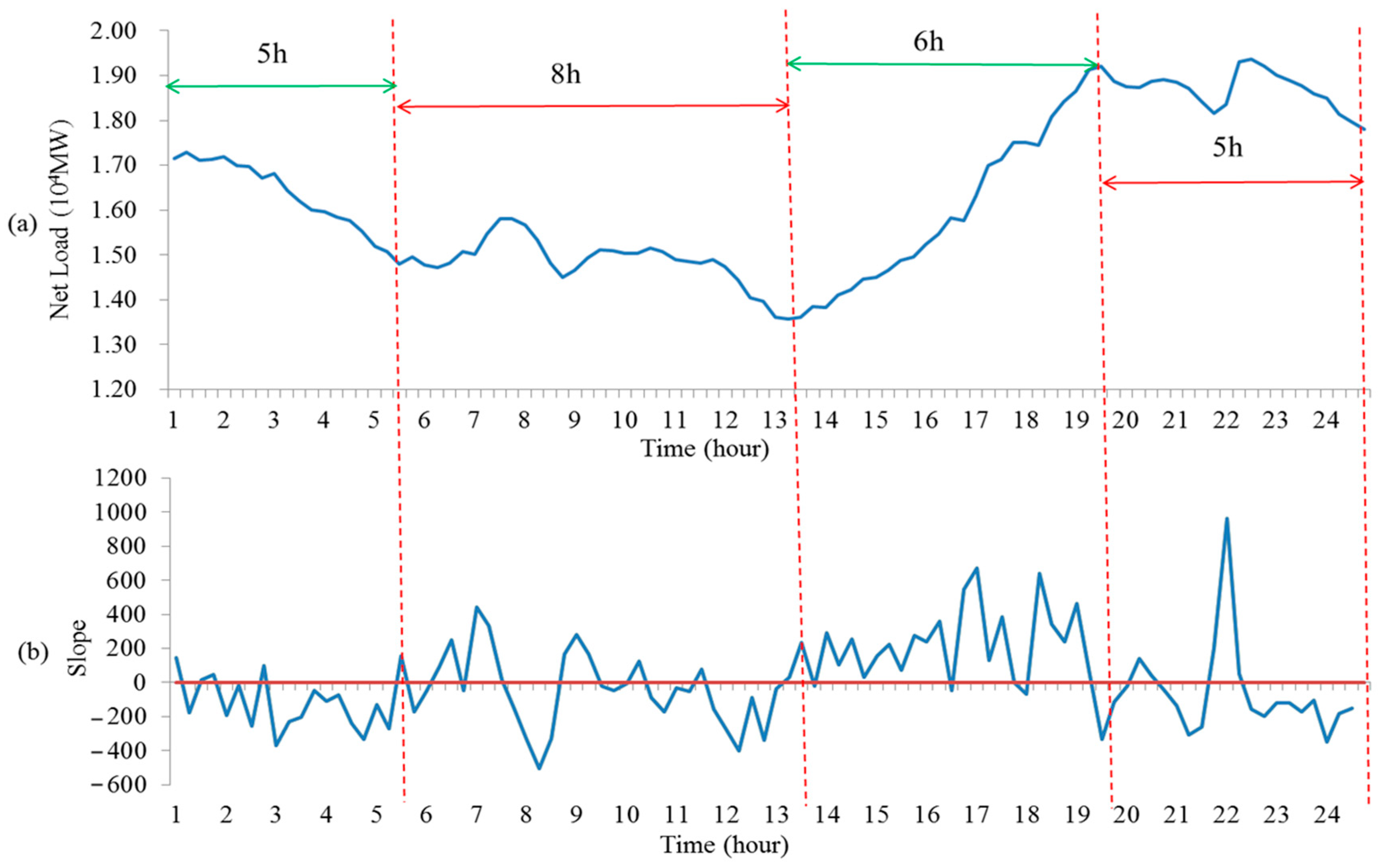

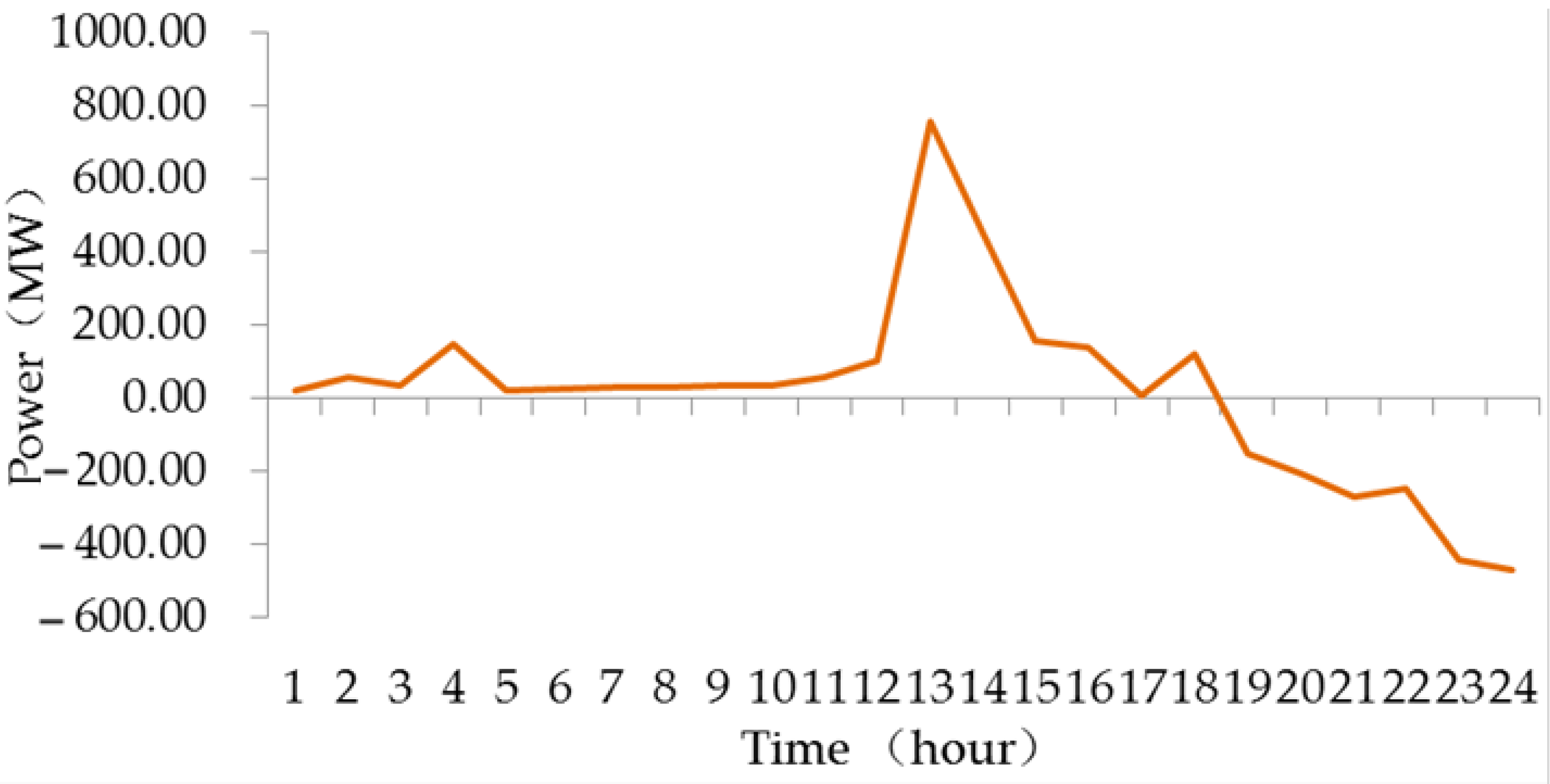
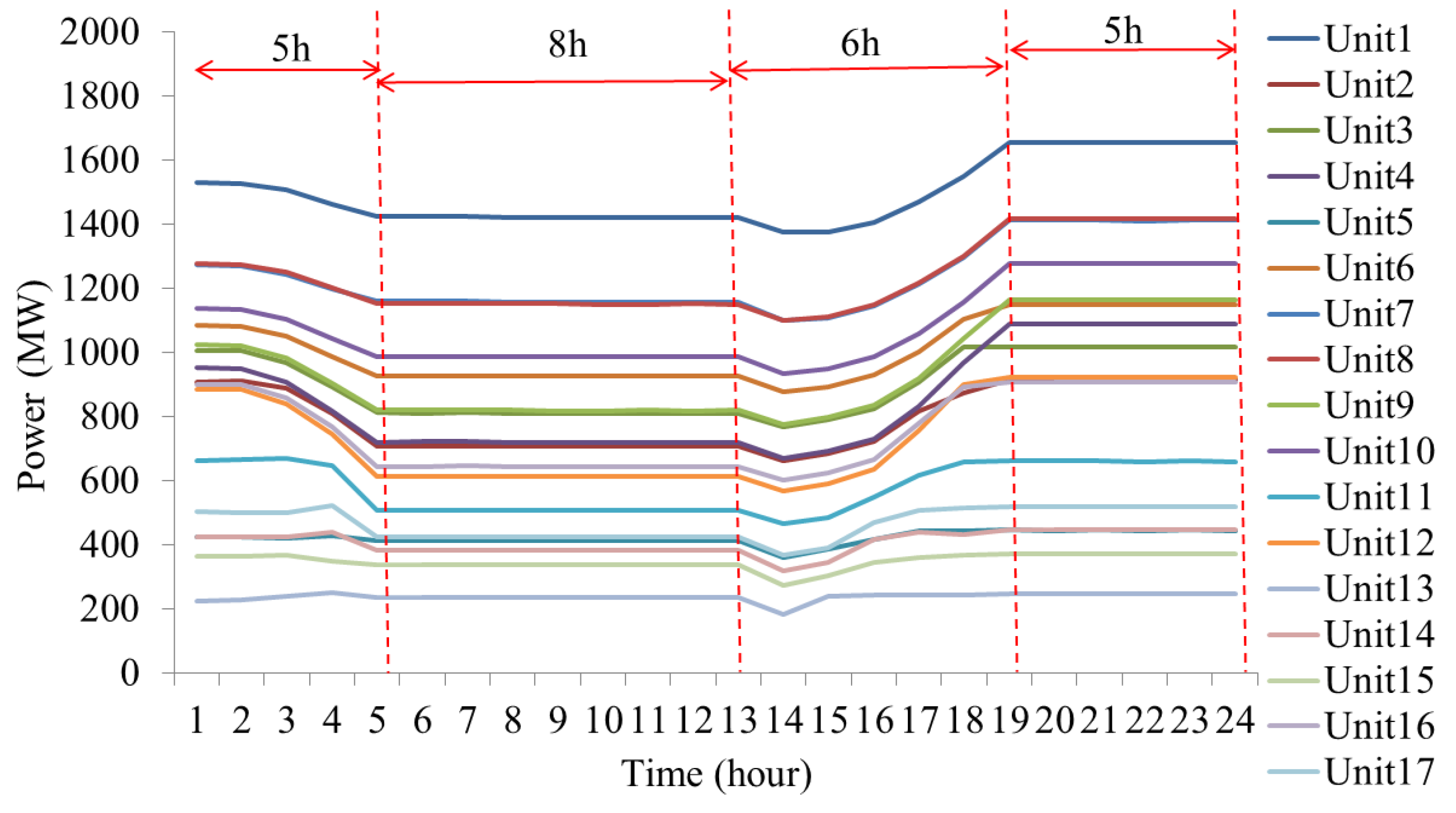
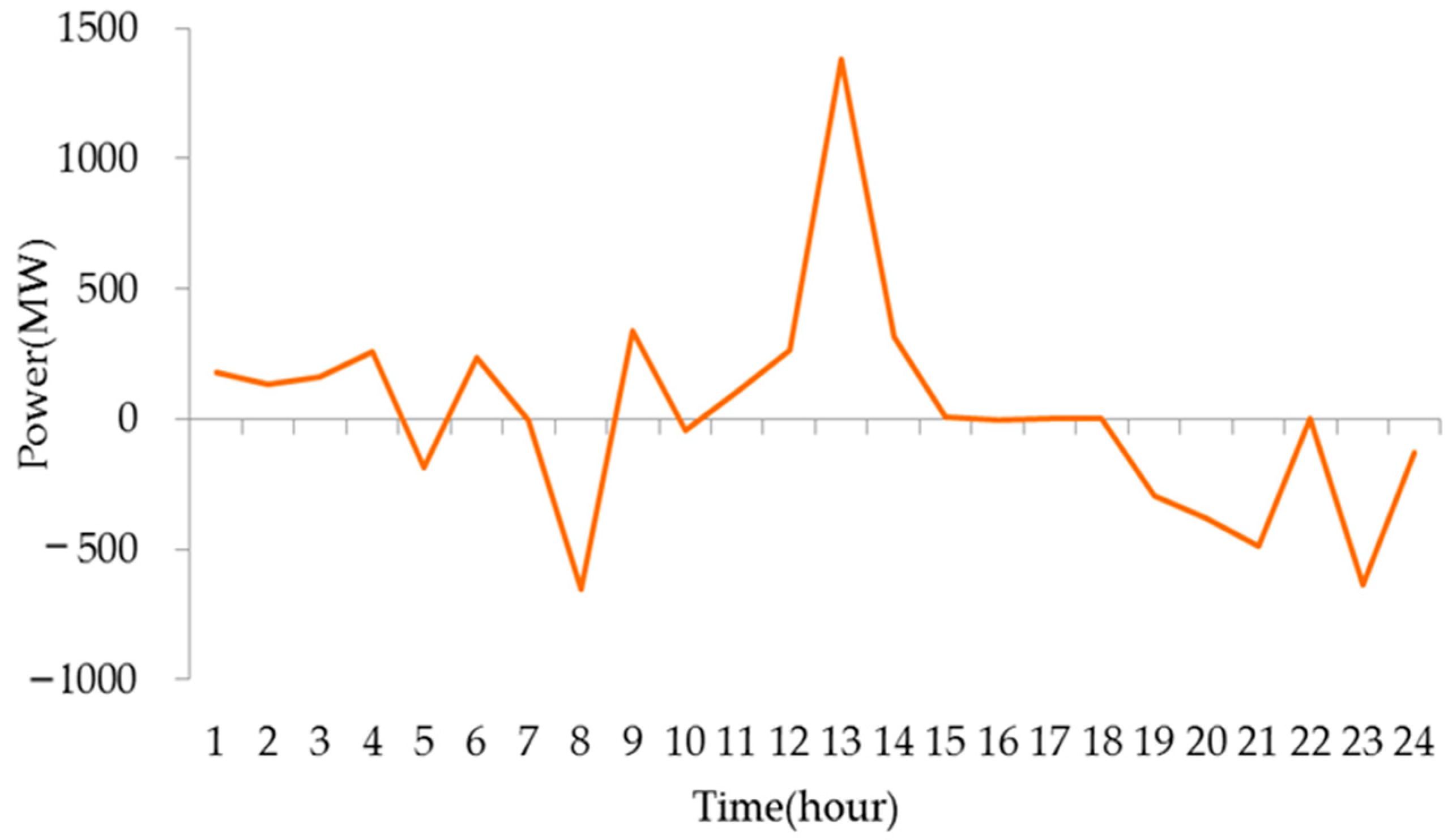
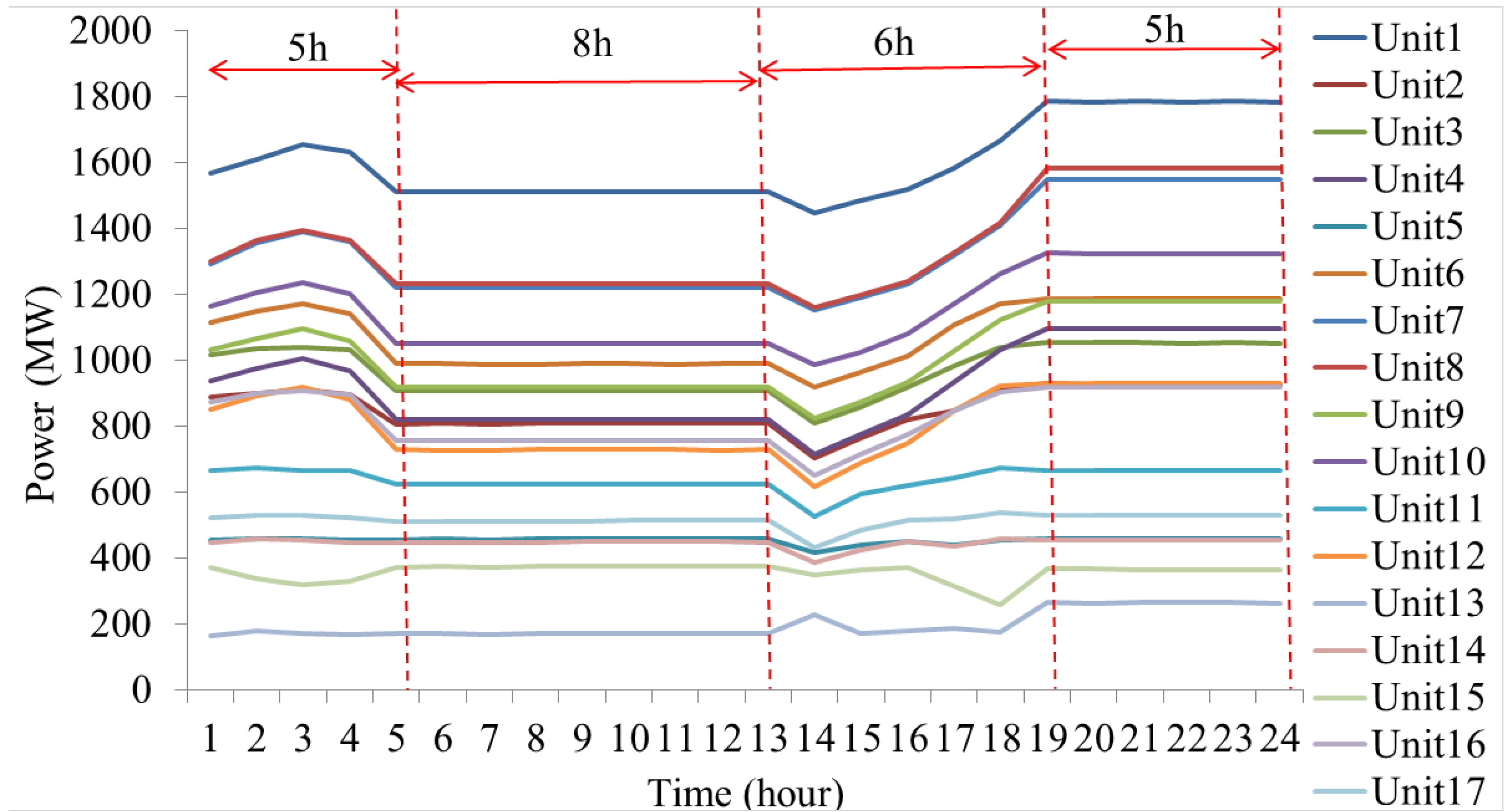
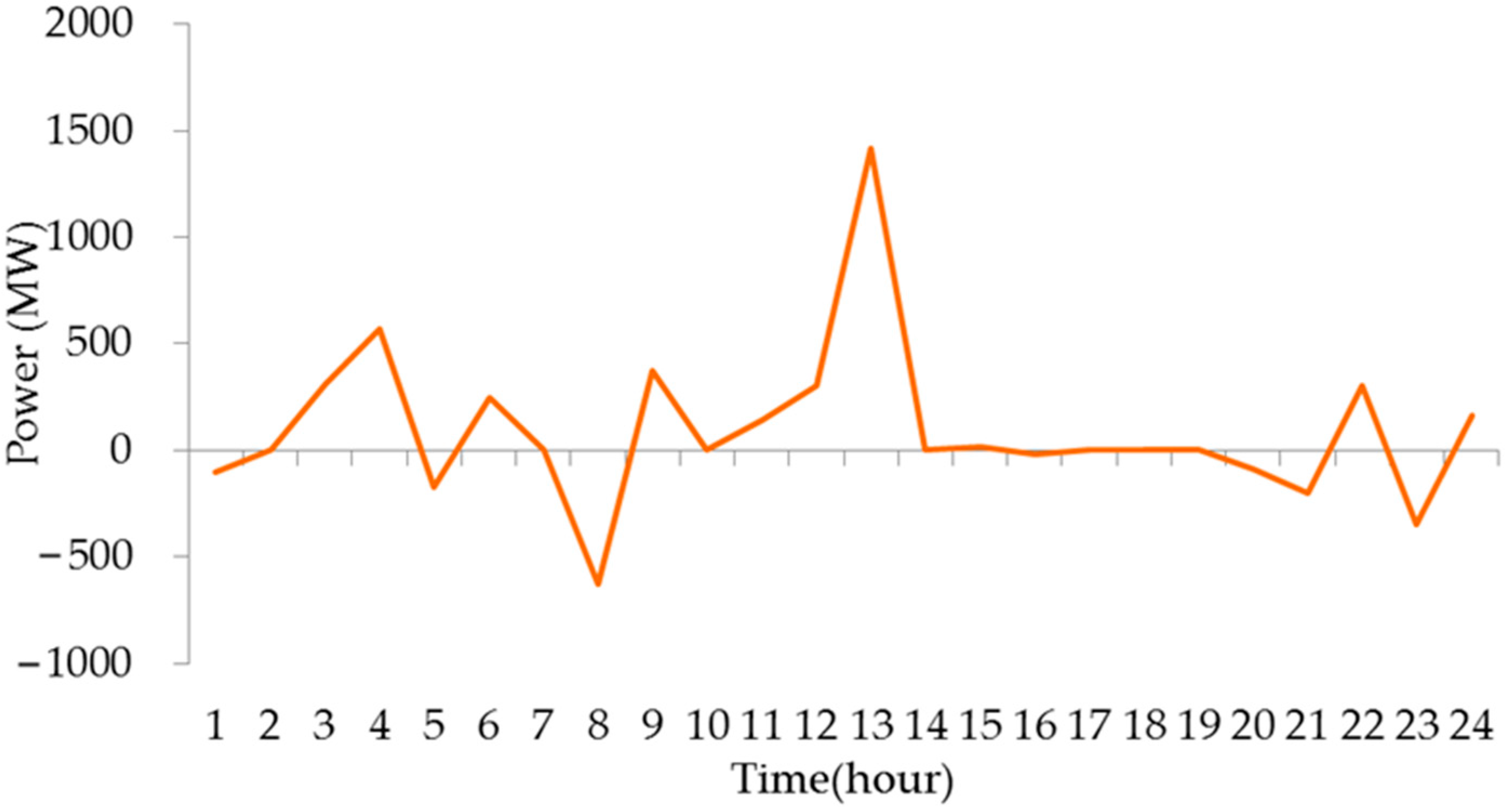
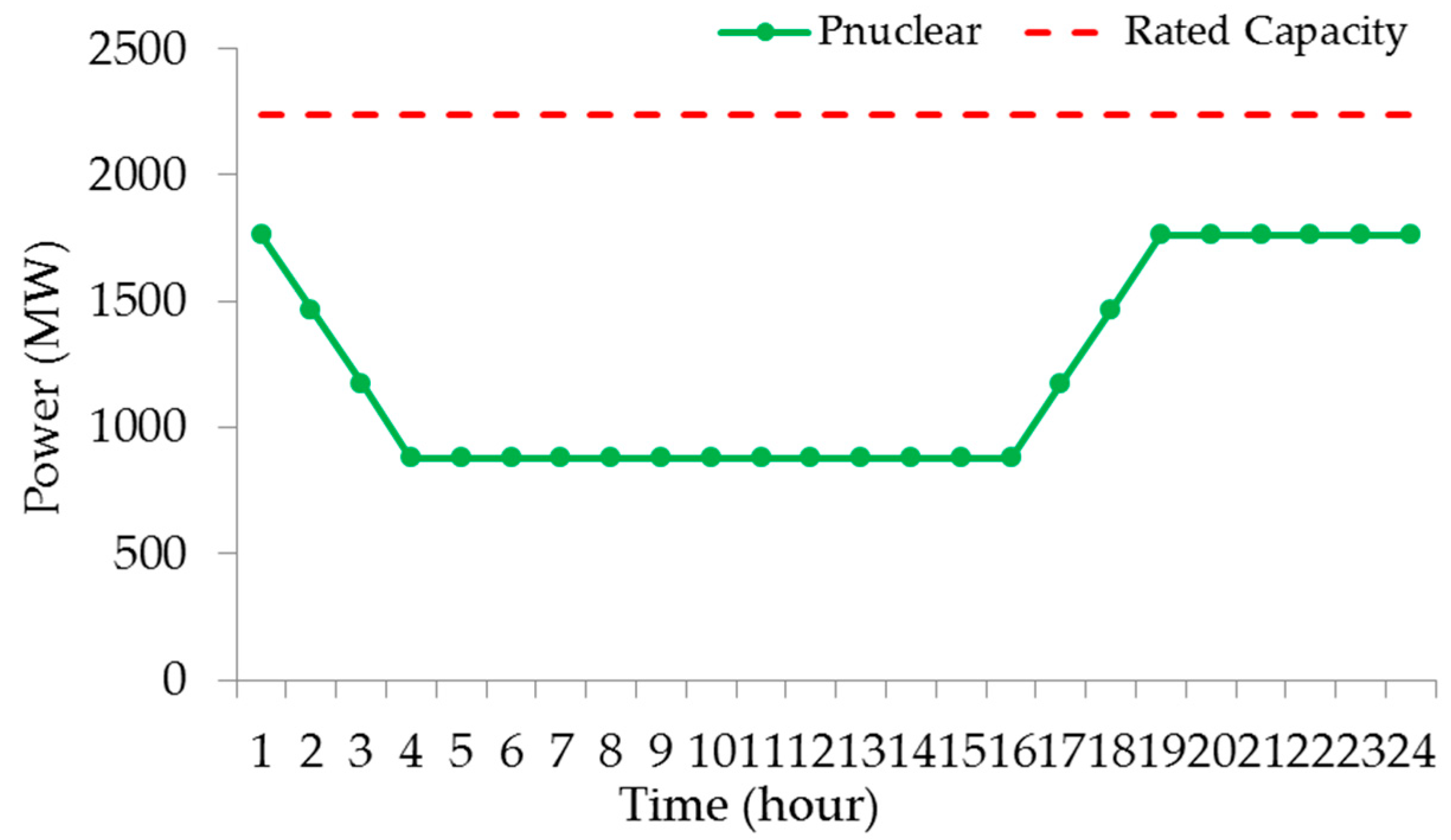
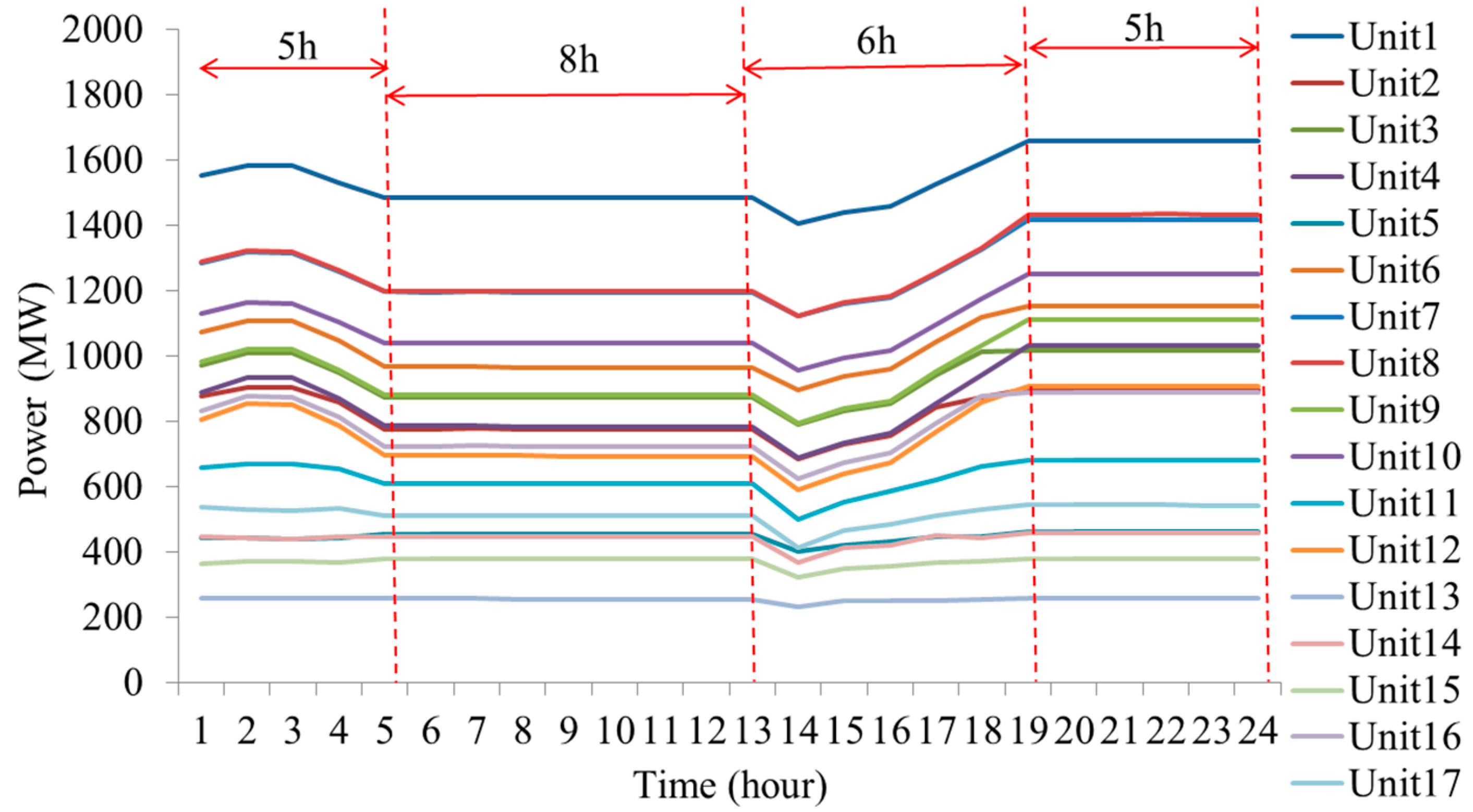


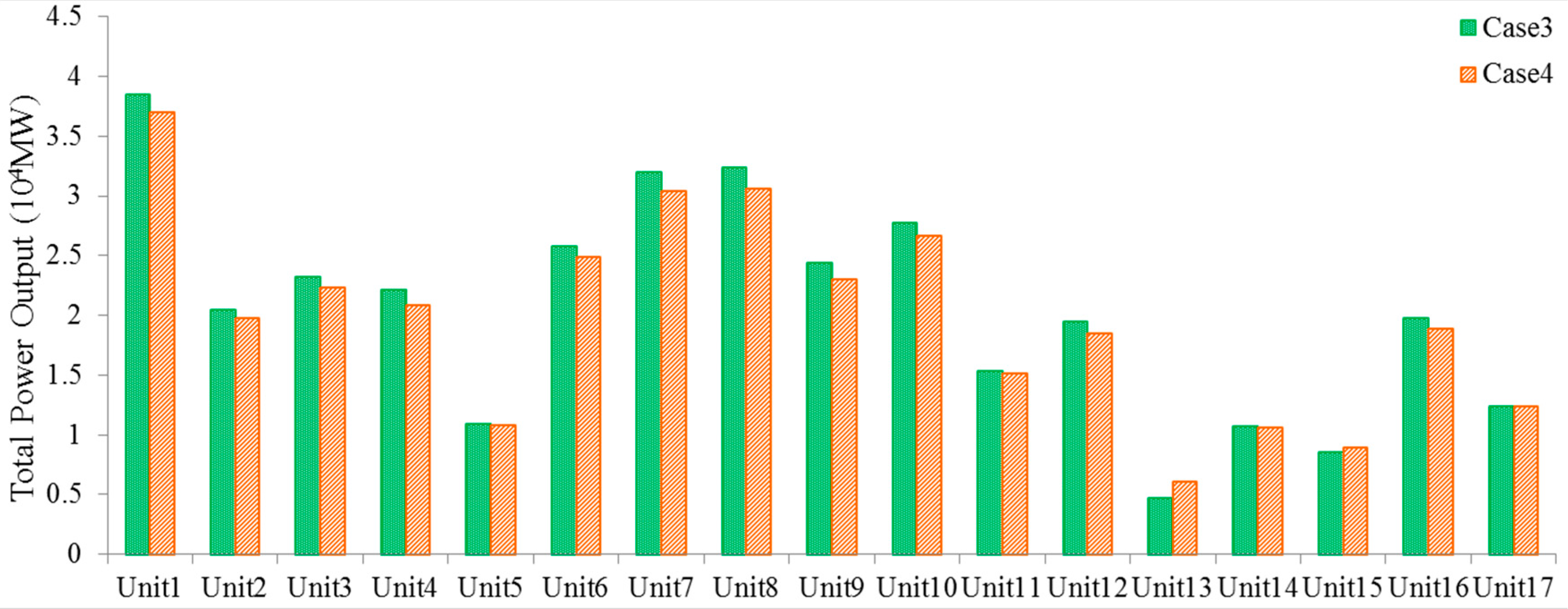
| Time Periods (h) | ||
|---|---|---|
| 1–5 | 0.5927 | 15% |
| 5–8 | 1.0817 | 28% |
| 8–13 | 0.9211 | 24% |
| 13–19 | 0.1832 | 5% |
| 19–24 | 1.0593 | 28% |
| Parameters | Case 1 | Case 2 | Percentage Optimization of Case 2 Compared to Case 1 |
|---|---|---|---|
| Total cost (107 yuan) | 8.3630 | 8.0018 | 4.32% |
| Thermal generation cost (107 yuan) | 7.5336 | 7.0543 | 6.36% |
| Nuclear operation cost (107 yuan) | 0.3303 | 0.4439 | −34.39% |
| Up ramping power (MW) | 6683.67 | 4364.19 | 34.70% |
| Down ramping power (MW) | 5839.75 | 3334.46 | 42.90% |
| Throughput of pumped storage (MW) | 4006.11 | 6190.17 | −54.52% |
| Parameters | Case 3 | Case 4 | Percentage Optimization of Case 4 Compared to Case 3 |
|---|---|---|---|
| Total cost (107 yuan) | 8.5384 | 8.4758 | 0.73% |
| Thermal generation cost (107 yuan) | 7.5971 | 7.3802 | 2.86% |
| Nuclear operation cost (107 yuan) | 0.4225 | 0.5951 | −40.86% |
| Up ramping power (MW) | 5070.79 | 4137.84 | 18.40% |
| Down ramping power (MW) | 3468.73 | 2991.86 | 13.75% |
| Throughput of pumped storage (MW) | 5399.92 | 6086.82 | −12.72% |
| Total thermal power outputs (105 MW) | 3.49 | 3.37 | 3.44% |
| Parameters | Case 2 | Case 4 | Percentage Optimization of Case 4 Compared to Case 2 |
|---|---|---|---|
| Total cost (107 yuan) | 8.0018 | 8.4758 | −5.92% |
| Thermal generation cost (107 yuan) | 7.0543 | 7.3802 | −4.62% |
| Nuclear operation cost (107 yuan) | 0.4439 | 0.5951 | −34.06% |
| Up ramping power (MW) | 4364.19 | 4137.84 | 5.19% |
| Down ramping power (MW) | 3334.46 | 2991.86 | 10.27% |
| Throughput of pumped storage (MW) | 6190.17 | 6086.82 | 1.67% |
| Parameters | Meaning |
|---|---|
| Traditional load time series | |
| Number of load | |
| Uncertain power output | |
| Net load | |
| The slope of the adjacent points | |
| The sign extraction of | |
| Marks of sign changing of the adjacent slope | |
| The ratio of slope sign variation to data size | |
| k | The data length |
| The segment points | |
| The set of segment points | |
| The matrix with ranks comprised by elements | |
| The maximum value of the upper triangular matrix in | |
| The minimum value of the upper triangular matrix in | |
| The subsequence of the net load at time | |
| The elements in | |
| The length of time series | |
| The distance of the subsequence and | |
| The tolerance level | |
| The dimension of subsequence | |
| The standard deviation of | |
| The actual average over all the vectors | |
| The sSample eEntropy of the subsequence during the time interval to | |
| The proportion of | |
| The threshold of the proportion | |
| (MW) | The real power output of unit j at time t |
| (MW) | The minimum power outputs of |
| (MW) | The maximum power outputs of |
| The time interval | |
| The column vector composed by the divided time intervals | |
| The total amount of the dispatching periods | |
| (yuan) | The thermal generation cost |
| (kg) | The environmental cost |
| (yuan) | The pumped storage operation cost |
| The number of the dispatchable thermal units | |
| H | The dispatchable pumped storage units |
| T | The number of hours in a day |
| (yuan/MW2) | The coefficients of fuel cost functions for thermal unit j |
| (yuan/MW) | The coefficients of fuel cost functions for thermal unit j |
| (yuan) | The coefficients of fuel cost functions for thermal unit j |
| (kg/MW2 h) | The coefficients of environmental cost for thermal unit j |
| (kg/MW h) | The coefficients of environmental cost for thermal unit j |
| (kg/h) | The coefficients of environmental cost for thermal unit j |
| (yuan/MW) | The pumping cost coefficient of pumped storages |
| (yuan/MW) | The generating cost coefficient of pumped storages |
| (MW) | The pumping power of pumped storage unit h at time t |
| (MW) | The generating power of pumped storage unit h at time t |
| The pumping state of pumped storage unit h | |
| The generating state of pumped storage unit h | |
| (yuan) | The pumping and generating state switching cost of pumped storage units |
| The pumping and generating state is switched from time t to time t + 1 | |
| N | The number of the dispatchable nuclear power units |
| (yuan/MW·h) | The coefficients of fuel cost functions for nuclear unit n |
| (yuan) | The coefficients of fuel cost functions for nuclear unit n |
| (MW) | The power output of nuclear power unit n at time t |
| The depth of peak -shaving | |
| (MW) | The rated operation power of the nuclear generator |
| (yuan) | The operation cost under rated power level |
| The auxiliary power ratio under the rated power level | |
| The auxiliary power ratio under power level | |
| (yuan) | The operation cost of nuclear power unit operating at |
| (yuan) | The peak -shaving fuel cost of nuclear power unit |
| (yuan) | The peak -shaving cost of nuclear power unit |
| (MW) | The total thermal generation power output during the tth time period |
| (MW) | The total nuclear generation power output during the tth time period |
| (MW) | The total net load demands at time t |
| (MW) | The predicted wind power of wind farm w at time t |
| (MW) | The predicted photovoltaic power of photovoltaic station s at time t |
| The total number of the wind farms | |
| The total number of the photovoltaic power stations | |
| (MW) | The ramp-up rate limits of the ith thermal generator |
| (MW) | The ramp-down rate limits of the ith thermal generator |
| (MW) | The actual up reserve of thermal generator j |
| (MW) | The actual down reserve of thermal generator j |
| (MW) | The actual wind power of wind farm w at time t |
| (MW) | The up reserve for photovoltaic power output |
| (MW) | The down reserve for photovoltaic power output |
| Normalized wind power output | |
| Beta distribution function | |
| The distribution shape parameters of Beta distribution function | |
| Y | The random variable |
| The fractile of | |
| The confidence coefficient | |
| (MW) | The minimum generating power of pumped storage |
| (MW) | The maximum generating power of pumped storage |
| (MW) | The minimum pumping power of pumped storage |
| (MW) | The maximum pumping power of pumped storage |
| (MW) | The storage condition of the reservoir at time t |
| The pumping efficiency of pumped storage | |
| The generating efficiency of pumped storage | |
| (MW) | The minimum power storage of reservoir |
| (MW) | The maximum power storage of reservoir |
| (MW) | The power output before the first time peak -shaving |
| (MW) | The power output before the second time peak -shaving |
| The maximum operation point-in-time of the first time peak -shaving | |
| The minimum operation point-in-time of the first time peak -shaving | |
| The maximum operation point-in-time of the second time peak -shaving | |
| The minimum operation point-in-time of the second time peak -shaving | |
| (MW) | The power output of nuclear generation n at time t |
| The minimum peak-shaving duration of the first time peak -shaving | |
| The minimum peak-shaving duration of the second time peak -shaving | |
| The minimum operation duration of nuclear power units operation at | |
| The minimum operation duration of nuclear power units operation at | |
| The maximum peak -shaving depth |
| Acronyms | Meaning |
|---|---|
| SampEn | Sample Entropy |
| NL | Net Load |
| IEA | International Energy Agency |
| NEA | Nuclear Energy Agency |
| ApEn | Approximate Entropy |
| a (yuan/MW2) | b (yuan/MW) | C (yuan) | α (kg/MW2 h) | β (kg/MW h) | γ (kg/h) |
|---|---|---|---|---|---|
| 0.0053 | 195.4667 | 3173.3 | 0.022 | −2.86 | 130 |
| 0.04 | 189.6 | 4760 | 0.072 | −2.72 | 132 |
| 0.04 | 189.6 | 4760 | 0.044 | −2.94 | 137 |
| 0.06 | 157.8 | 6300 | 0.058 | −2.35 | 130 |
| 0.2 | 112.8 | 19,440 | 0.087 | −2.36 | 125 |
| 0.06 | 157.8 | 6300 | 0.061 | −2.28 | 110 |
| 0.0088 | 184.36 | 1176 | 0.032 | −2.36 | 135 |
| 0.0033 | 160.667 | 7933.3 | 0.019 | −1.29 | 157 |
| 0.05 | 126.5 | 16,590 | 0.051 | −1.14 | 160 |
| 0.04 | 164.4 | 3240 | 0.046 | −2.14 | 137.7 |
| 0.1 | 183.6 | 2880 | 0.076 | −2.12 | 125 |
| 0.05 | 92.5 | 13,650 | 0.062 | −2.26 | 142 |
| 0.765 | 191.88 | 368.55 | 0.09 | −2.03 | 133 |
| 0.2 | 159 | 10,800 | 0.078 | −2.67 | 155 |
| 0.433 | 184.267 | 3173.3 | 0.082 | −2.01 | 160 |
| 0.0733 | 177.2 | 2730 | 0.066 | −2.88 | 130 |
| 0.0822 | 163.6 | 9240 | 0.077 | −2.76 | 159 |
© 2020 by the authors. Licensee MDPI, Basel, Switzerland. This article is an open access article distributed under the terms and conditions of the Creative Commons Attribution (CC BY) license (http://creativecommons.org/licenses/by/4.0/).
Share and Cite
Sui, X.; Lu, S.; He, H.; Zhao, Y.; Hu, S.; Liu, Z.; Gu, H.; Sun, H. Wind-Thermal-Nuclear-Storage Combined Time Division Power Dispatch Based on Numerical Characteristics of Net Load. Energies 2020, 13, 364. https://doi.org/10.3390/en13020364
Sui X, Lu S, He H, Zhao Y, Hu S, Liu Z, Gu H, Sun H. Wind-Thermal-Nuclear-Storage Combined Time Division Power Dispatch Based on Numerical Characteristics of Net Load. Energies. 2020; 13(2):364. https://doi.org/10.3390/en13020364
Chicago/Turabian StyleSui, Xin, Shengyang Lu, Hai He, Yuting Zhao, Shubo Hu, Ziqian Liu, Hong Gu, and Hui Sun. 2020. "Wind-Thermal-Nuclear-Storage Combined Time Division Power Dispatch Based on Numerical Characteristics of Net Load" Energies 13, no. 2: 364. https://doi.org/10.3390/en13020364
APA StyleSui, X., Lu, S., He, H., Zhao, Y., Hu, S., Liu, Z., Gu, H., & Sun, H. (2020). Wind-Thermal-Nuclear-Storage Combined Time Division Power Dispatch Based on Numerical Characteristics of Net Load. Energies, 13(2), 364. https://doi.org/10.3390/en13020364





